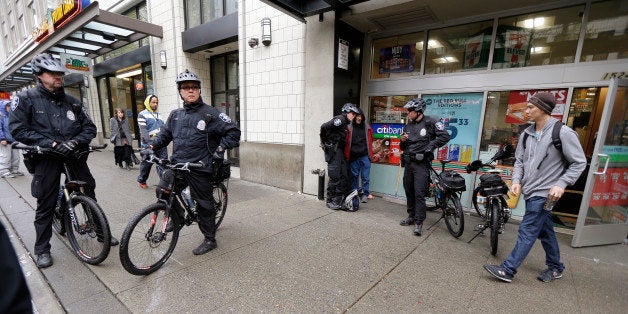
One of the most innovative reforms in the country is one you've probably never heard of. That's about to change, because Law Enforcement Assisted Diversion (LEAD) is transforming the national discussion about how to end the war on drugs and mass incarceration.
LEAD began in Seattle 2011, a bold new response to a familiar problem. After decades of waging a war on drugs in Seattle, nobody was satisfied with results -- drug use and addiction were just as prevalent as ever, incarceration rates had skyrocketed, the entire system was marked by outrageous racial disparities -- and the whole thing cost a fortune. To top it off, there weren't any real benefits to public safety or health. Everyone was frustrated and ready for a new approach.
A unique collaboration came together to devise a new plan. The group included law enforcement, public defenders, human service agencies, business leaders, community groups, and elected officials. The group identified shared goals, and created a process to achieve them -- LEAD. Under LEAD, police officers identify people committing low-level criminal offenses; but after arrest, instead of booking them into jail, the officer links the individual to a waiting case manager. The case manager then integrates the individual into a highly coordinated, harm-reduction focused continuum of human services -- including housing, counseling, job training, drug treatment, mental health services, and health care. There is no jail, no criminal prosecution, no courts.
And it works. A new evaluation report published today shows that LEAD reduces the number of people caught up in the criminal justice system while also achieving a nearly 60 percent reduction in recidivism. Additional data strongly suggest that LEAD improves the health and well-being of people struggling at the intersection of poverty and drug and mental health problems. Perhaps these outcomes shouldn't be surprising: another report, published last year, found that LEAD improves coordination among multiple stakeholders who for too long have been working at cross purposes.
LEAD is better described as a process than a program, and holds significance beyond its proven effectiveness. It represents a paradigm shift: multiple sectors -- police, health, housing, business, political, and community leaders -- working together to reduce the role of the criminal justice system in responding to low-level criminal offenses like drug use, sales and position. Its harm reduction framework makes LEAD is far less coercive than some other diversion models, like drug courts, that rely on sanctions and other punishments. These models often result in program participants spending more time entangled in the criminal justice system than if they were traditionally sentenced and incarcerated. LEAD bypasses this entirely by diverting people at the point of police contact. And because of LEAD's harm reduction orientation, abstinence is an option, but not the primary objective.
By establishing smart solutions that don't rely on prosecution, courts, or jails, Seattle's LEAD is the cutting edge of criminal justice reform in the nation. LEAD's successes at the local level have already had an impact on larger policy debates about drugs and criminal justice. With the release of today's favorable evaluation report, Seattle is planning to expand LEAD to its entire downtown sector. And other municipal jurisdictions are paying attention. In 2014, Santa Fe, NM became the second jurisdiction to launch LEAD. Cities and counties throughout the U.S. have sent representatives to Seattle to learn about LEAD, because it is a way for local jurisdictions to unwind the failed war on drugs, address racial disparities, and improve criminal justice practices without waiting for policy change to come from state legislatures or from Congress. It's a big step toward ending criminalization of drug possession and addiction.
To truly end the war on drugs and mass incarceration, we need to develop new approaches to achieve health and safety. This will, by definition, require transformation of existing systems, institutions, and practices. The evaluation published today shows that LEAD is one good, proven method to get us closer to this goal. It's about time.